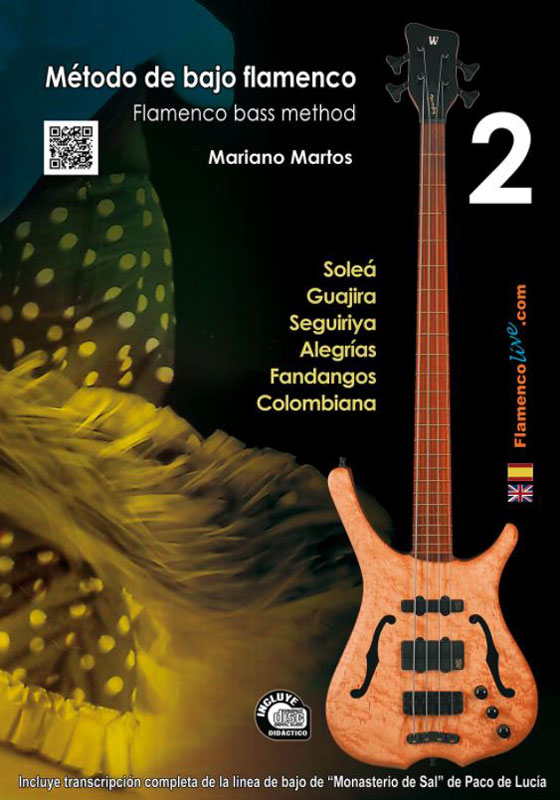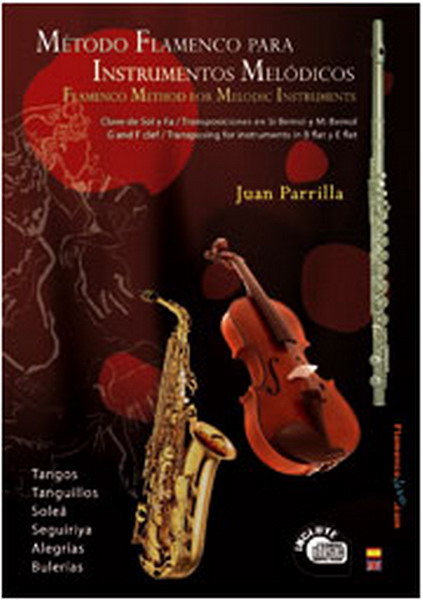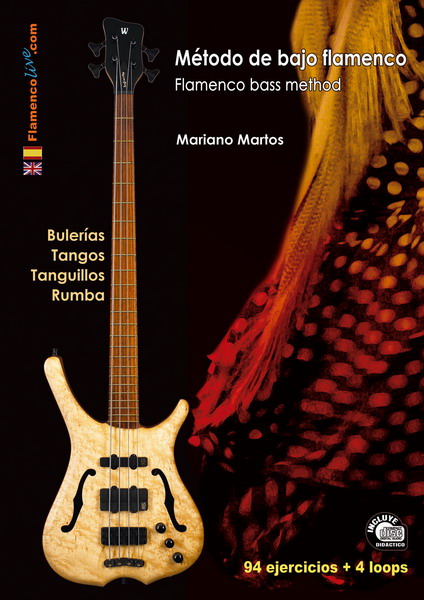- Contacto |
-
Teléfono
|
(+34) 91 542 72 51.
We’re open from Monday – Friday 10h-13:30h / 17:00-20:00h and Saturdays 10h-13:30h (GMT + 1).
In 2024, we will be closed for holidays on the 1st and 6th January, 28th, 29th, and 30th March, 1st, 2nd, and 15th May, 25th July, 15th August, 12th October, 1st and 9th November, 6th, 7th, and 25th December.
Our shop is located in Calle Campomanes nº 4, Madrid 28013 España (Ópera Metro Station) - Ayuda |
- Lista de precios |
- Situación de pedido |
- Acceso Mayoristas
- 🚚 📦 WORLDWIDE SHIPPING ✈️ 🌍
Flamenco Bass Method 2 Mariano Martos
Mariano Martos starts playing the guitar like self-taught when he’s 8 years old. He played alone until 1983 when he plays also the electric bass. After a work of 6 years he finish in 2008 a pioneer book: “Flamenco Bass Method” and now he presents his new work “Flamenco Bass Method 2”.
The method is divided into six chapters, each of which corresponds to a different flamenco style, or palo. These are the Soleá, Guajira, Seguiriya, Alegrías, Fandango and Colombiana.
Each of these contains:
- Rhythmic Section / Analysis and description.
1). Relevant explanation.
2). Basic pattern of the palo.
3). Ways of feeling the pulse.
4). Basic structure, Harmonic Rhythm, Accents.
- Basic pattern.
Different developments of the patterns.
- Complete rhythmic cycle or compás.
Sample of the compás and traditional accompaniment with the most developed basic pattern. Pertinent explanations are given on the notes signalled in each stave.
- Falseta.
Sample of an original falseta (short musical phrase performed by the guitar) combining basic compás with personal creation. Contains the section "Analysis of form and content in the bass line.”
- Falseta solo.
The same falseta from its corresponding palo of the chapter, but mixed and produced in the usual way, with the normal stereo panning of original music. The metronome is muted for the same reason. The idea behind including this mix is to show the student how the music would sound in an edited recording.
The book also contains two sections, which explain:
1). Study guide.
2). Resources for the development of ideas in bass line compositions.
Traditional music notation is used, along with chord diagrams and TAB for four string bass. In the falsetas there is no TAB.
A CD is included with the book, containing all the recorded material in open panning so you can listen with the click:
1). The complete exercise in the middle track.
2). The bass solo with click on the right.
3). The exercise by itself (no bass) with the metronome on the left track.
In the chapter on Colombianas a complete transcription of Paco de Lucia’s composition called Monasterio de Sal is included. This is a key piece in the beginning of what today we can call the Flamenco Bass..
Notation and tablature
Spanish, English
A4, 72 pages
Mariano Martos starts playing the guitar like self-taught when he’s 8 years old. He played alone until 1983 when he plays also the electric bass. After a work of 6 years he finish in 2008 a pioneer book: “Flamenco Bass Method” and now he presents his new work “Flamenco Bass Method 2”.
The method is divided into six chapters, each of which corresponds to a different flamenco style, or palo. These are the Soleá, Guajira, Seguiriya, Alegrías, Fandango and Colombiana.
Each of these contains:
- Rhythmic Section / Analysis and description.
1). Relevant explanation.
2). Basic pattern of the palo.
3). Ways of feeling the pulse.
4). Basic structure, Harmonic Rhythm, Accents.
- Basic pattern.
Different developments of the patterns.
- Complete rhythmic cycle or compás.
Sample of the compás and traditional accompaniment with the most developed basic pattern. Pertinent explanations are given on the notes signalled in each stave.
- Falseta.
Sample of an original falseta (short musical phrase performed by the guitar) combining basic compás with personal creation. Contains the section "Analysis of form and content in the bass line.”
- Falseta solo.
The same falseta from its corresponding palo of the chapter, but mixed and produced in the usual way, with the normal stereo panning of original music. The metronome is muted for the same reason. The idea behind including this mix is to show the student how the music would sound in an edited recording.
The book also contains two sections, which explain:
1). Study guide.
2). Resources for the development of ideas in bass line compositions.
Traditional music notation is used, along with chord diagrams and TAB for four string bass. In the falsetas there is no TAB.
A CD is included with the book, containing all the recorded material in open panning so you can listen with the click:
1). The complete exercise in the middle track.
2). The bass solo with click on the right.
3). The exercise by itself (no bass) with the metronome on the left track.
In the chapter on Colombianas a complete transcription of Paco de Lucia’s composition called Monasterio de Sal is included. This is a key piece in the beginning of what today we can call the Flamenco Bass..
Notation and tablature
Spanish, English
A4, 72 pages

















